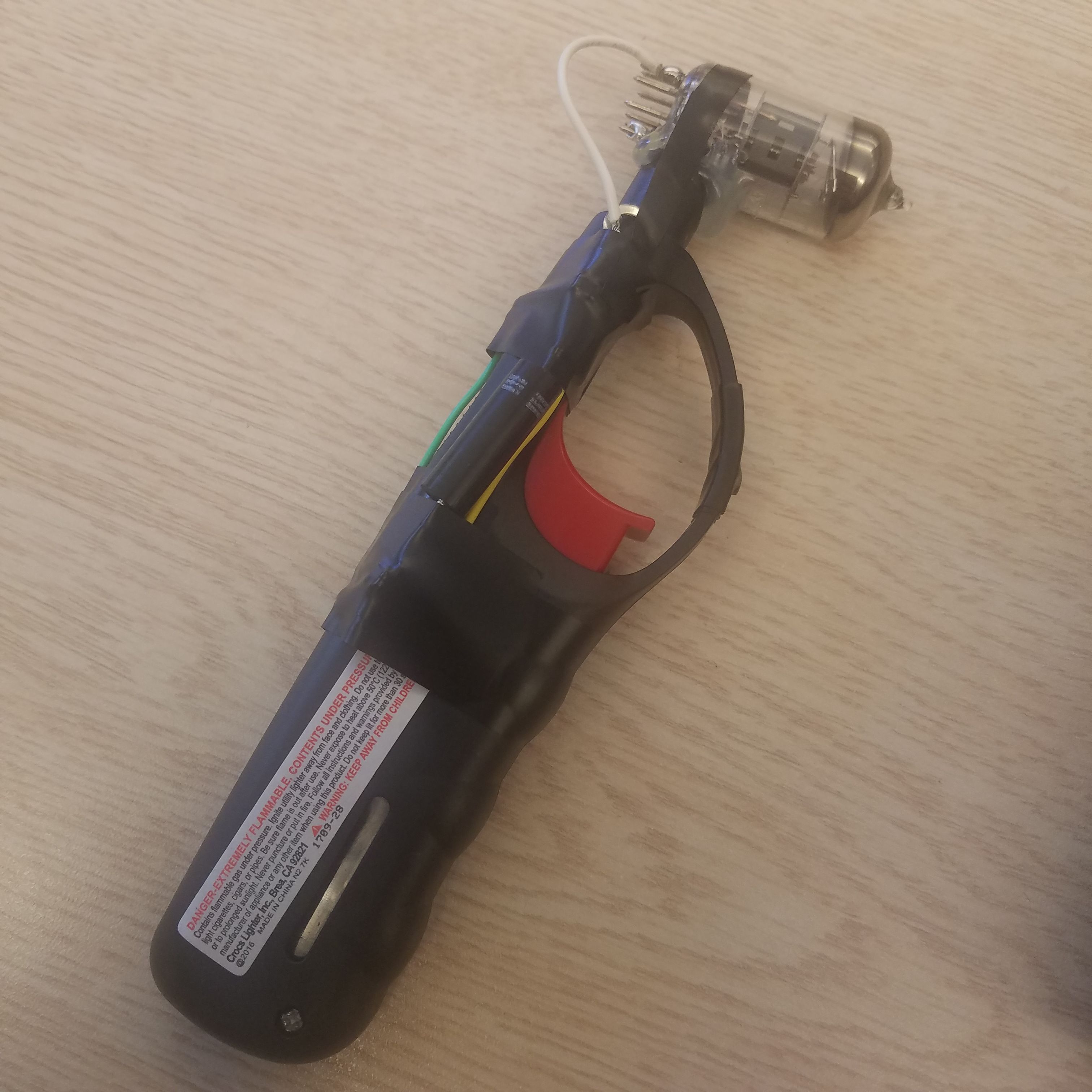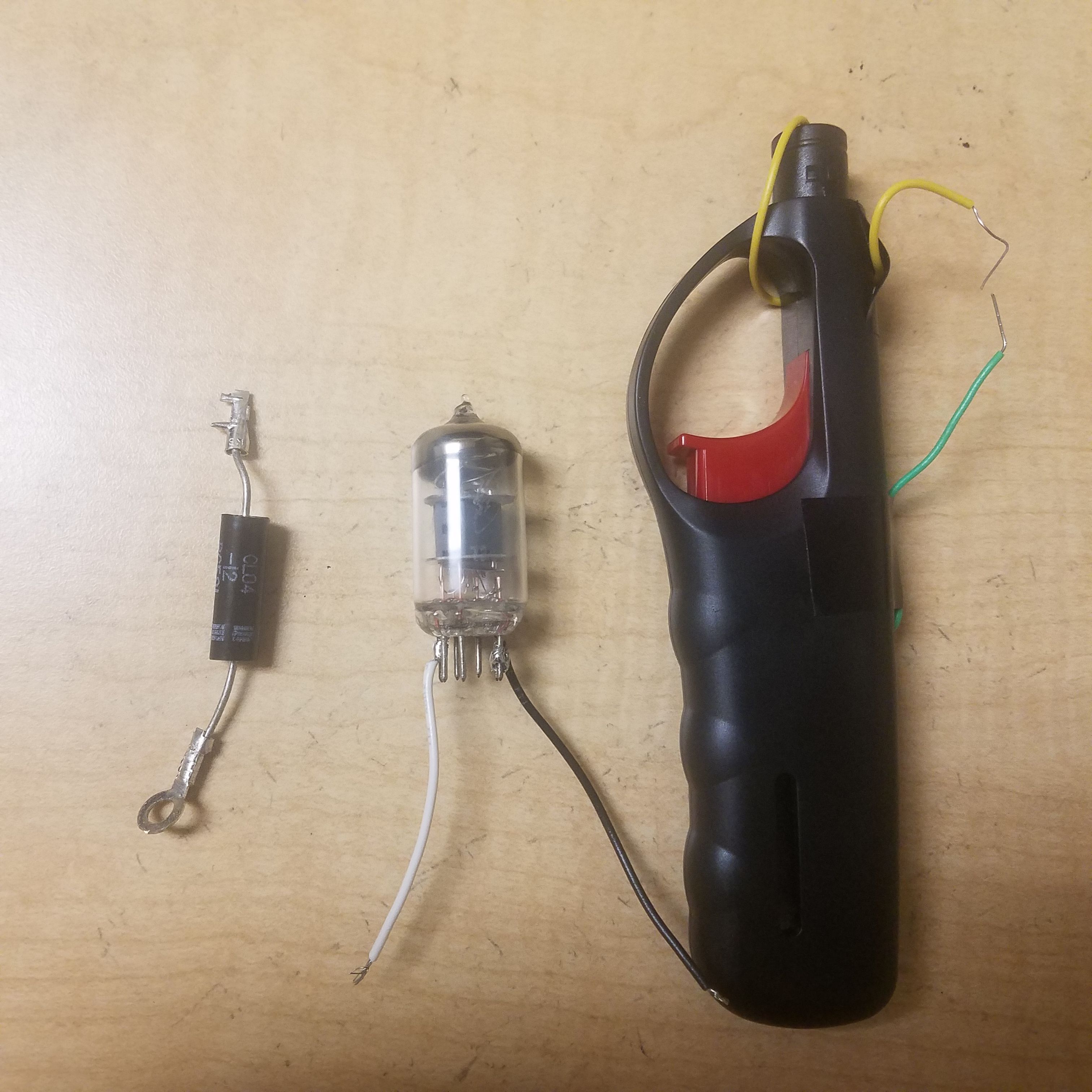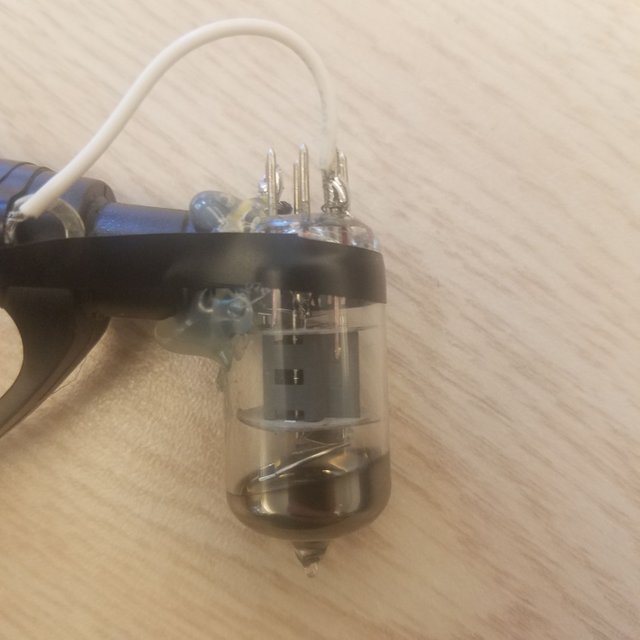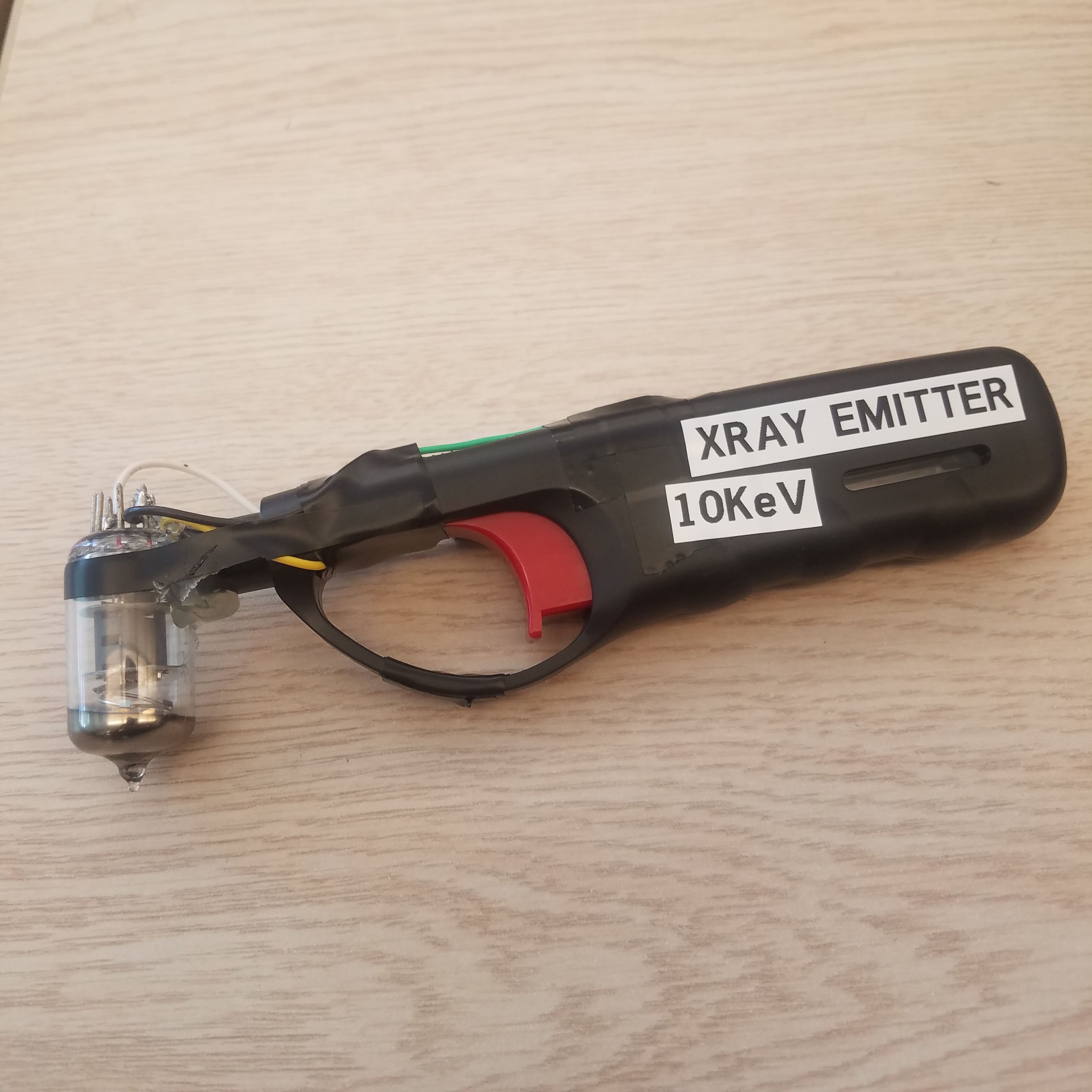My X-Ray emitter device built from a barbecue lighter
Recently I completed a small project - I created a little X-ray radiation source using a barbecue lighter and a vacuum tube. When you pull the trigger, a short pulse of X-rays is produced inside the tube. These X-rays can be detected by all of my radiation detectors, but so few of them are produced by each trigger pull that it is perfectly safe to use it as many times as you could possibly imagine with absolutely no radiation health risks.
The device also doesn't need a battery - all of the energy used to generate the X-rays is generated when you pull the trigger.

In this post I'll explain exactly how it works.
Piezoelectric High Voltage
Your average dollar-store barbecue lighter works by generating a high voltage arc across the metal lighter tube. This arc is essentially a stream of hot plasma, which ignites the gas and starts up the flame.
This arc is produced in the usual way by a strong electric field. This electric field in turn is produced by something called a piezoelectric crystal. Piezoelectric crystals generate charge differences (ie a voltage) when some sort of mechanical stress (bending, cracking, impact, etc) is applied to them.
I've already written a lot about the crystals found in these lighters (see here if you are interested), but I'll quickly recap. When you pull the trigger of a barbecue lighter, a spring-loaded piston slams into a piezoelectric crystal with quite a bit of force. This puts a lot of stress on the crystal, causing it to produce a high voltage difference that produces the arc (if the wires are close enough together).
X-Ray Emission in Vacuum Tubes
Once again, I've already written a lot about producing X-Rays using vacuum tubes in this post. For completeness, I'll review here.
A basic vacuum tube rectifier consists of a conductive filament and a metal plate separated by a vacuum. Ordinarily, current doesn't flow across the tube unless you heat up the filament causing it to release electrons into the vacuum gap.
If a very high (1000V+) voltage is connected across the tube, electrons can tunnel out of the filament even without heating up the filament. These electrons are accelerated across a strong electric field until they strike the metal plate. When electric charges accelerate, they produce electromagnetic radiation. When the electrons hit the plate, they are rapidly decelerated producing high energy electromagnetic radiation - namely XRays.
The rule of thumb is 1 eV of kinetic electron energy per volt applied across a vacuum tube. So, a 10000 volt tube will produce 10 keV electrons, which will produce upon impact a spectrum of XRays, with a maximum energy of 10 keV.
Speaking of 10 keV, that's about the energy threshold for significant amounts of XRays escaping a vacuum tube. Below 10 keV, photons will be absorbed into the glass walls, but above this energy they can escape and be detected in a radiation detector. This means that if you connect a high voltage power supply to a vacuum tube, you'll produce a slew of XRays (if the voltage is above about 10000 volts).
Barbecue Lighter XRays
While testing some 6J1 vacuum tubes (cheap Chinese rectifier tubes) with a bigger power supply, I remembered that I had a few disassembled lighters with the high voltage output exposed (this can be easily done by removing the gas feed line). I connected the output of the lighter to the tube, pulled the trigger, and ... my geiger counter went off, indicating XRays.

But unfortunately that wasn't quite the end. After having fun firing the tube maybe a dozen times, it stopped producing X-rays. Removing the tube, I found that the lighter would even consistently produce arcs anymore. Several dead barbecue lighters later I determined that the piezoelectric crystal was self-destructing somehow after a few pulses.
It turns out that the vacuum tube appears to be acting as a capacitor. When you pull the trigger, the opposing plates inside the tube are charged up to a high voltage. Some of this charge is dissipated as electrons tunnel out of the filament and cross the gap, but not all of the voltage across this "capacitor" can be removed. Shortly after firing, the crystal loses its potential difference, causing the tube to discharge its leftover charge back into the crystal, destroying/damaging the crystal.
At least, that was the idea - an idea that I seem to have confirmed. I tried to fix this issue by placing a small rectifier diode in series with the tube, which should theoretically block the tube from discharging through the crystal. This did nothing to help - because I had used a 1N4001 diode, which can only take about 50 volts of reverse bias. Essentially, the charged up tube was punching right through this flimsy little diode.
To solve this issue, I upgraded to the biggest diode I have: a large diode I extracted from a microwave oven awhile back. These diodes are used to double the output voltage of a transformer, and typically take about 2000 volts across them during regular use. The datasheet I found states that my particular diode will take up 15000 volts in reverse bias before letting up, making it the perfect device to fix my barbecue lighter X-ray emitter (which I'm pretty sure doesn't produce much over 10000 volts).
Adding the microwave diode fixed the problem. After assembling the device, it worked well many times without the crystal becoming damaged. To make it permanent, I just used a bunch of solder, hot glue, and electrical tape to assemble the whole thing.

Uses
Aside from showing off and scaring people, this device is actually quite useful for testing detectors. Since the x-rays it produces are able to make it to the center of my SBM-20 based geiger counter (along with the CDV-700 which has an easier time detecting these counts), the lighter can be used to test most radiation detectors (I expect it would have even less trouble setting off a solid state photodiode detector).
It uses no external power source (all energy comes from your hand when you pull the trigger), so it doesn't need to be charged and can sit around indefinitely when not in use. Once you need to test something, just point the vacuum tube at it and pull the trigger (just be sure to be within a few inches or you won't detect anything at all).

The benefit of this over a permanent source is that this lighter is about as safe as it gets when it comes to radiation producing devices. While a radioactive source will decay away nonstop (and there is absolutely nothing you can do to stop it), this device will only produce radiation when intentionally used. It also emits absolutely tiny amounts of x-rays (only a few photons get to the detector per trigger pull), so in terms of radiation dose received, it is the safest easily detectable radiation source I can think of.
For the record, I'm not trying to say that radiation sources are typically dangerous. Most radiation sources you can buy (smoke alarm disks, uranium ore, thorium stickers, etc) are absolutely harmless. However, this lighter is even more than harmless.
Unfortunately I have run into several new issues. After about 3 days of heavy use (showing it to people I know mostly) the lighter stopped working consistently. I took it apart and replaced the lighter, at which point it started working again only to break down again in only a few hours. I expect there is some new reliability issue that needs to be solved (perhaps the diode was damaged somehow?), but that's something for another day. I expect if the device hadn't been abused by probably 500+ clicks in two or three days it would have lasted longer, and adding a second diode in series would ensure that the tube is in no way able to damage the crystal (unless the issue is sourced somewhere else...).
Either way, it's an easy fix, since these lighters come from the dollar store and are basically disposable.
Let me know if you have any questions, comments, or corrections.
Thanks for reading!
All images not sourced are my own. You are welcome to use them with credit.

That is an interesting way to use BBQ lighter! Regarding hazards of XRay emission - A couple of generations of people sat in front a similiar device (Television CRT's) although most of the X Ray emissions were blocked.
CRTs have way more current and voltage behind them, but had the benefit of being made of lead glass that massively reduced the x-ray emission. I've never actually tried to measure the x-ray emission of a CRT (I guess because I don't own one anymore), but it's something I'd like to try.
A nice and fancy project! :) Concerning CRTs: I am using an ancient device in our lab, with only a monochrome screen. I need to get my hands on a geiger or similiar, as I am dead sure there is almost no absorption of X-rays from the screen... :) At least I cannot see my bones when I hold my hand in front of it... xD
Very cool explanation of how this homemade x-ray gun works and how you troubleshot the initial issues. Hopefully you get it to work for longer than a few days, though the cheap-dollar store material might be preventing that.
This is super-cool. I think that I am going to put this one on my tinkering to do list.
Be careful, it's a slippery slope from this to some sort of doomsday device.